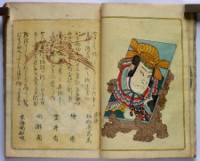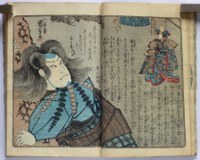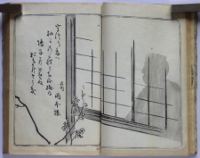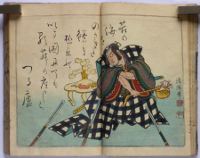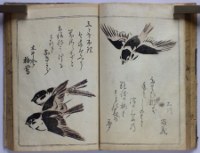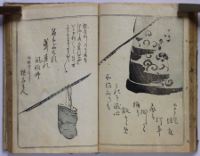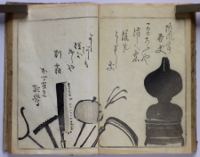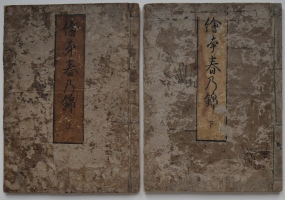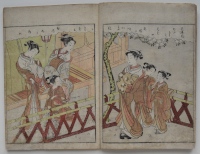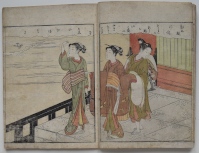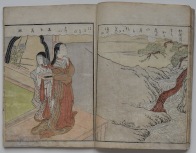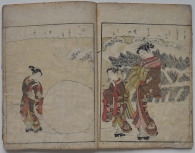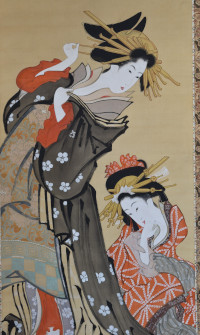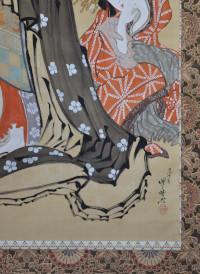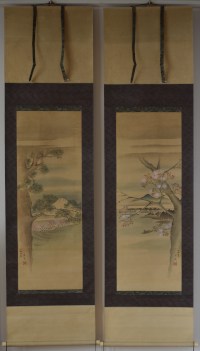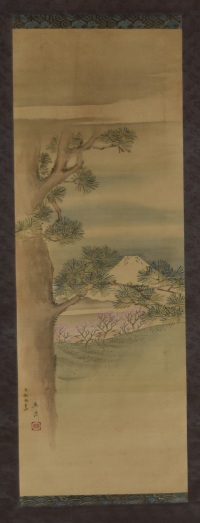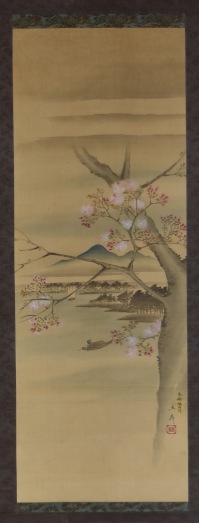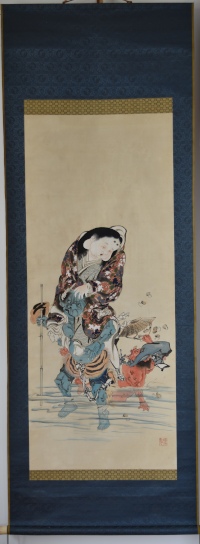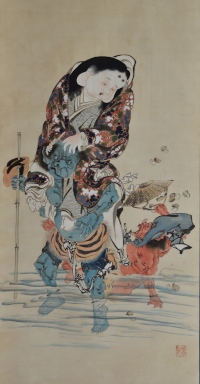Katsukawa SHUNSHO II (Active 1818-1830)
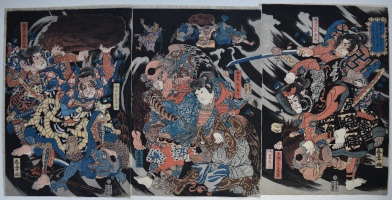
Click here to view image full size.
Minamoto no Yoshinaka Shitenno to tomoni Kiso no okuyama ni Tengu o taiji su, “Minamoto Yoshinaka and His Four Retainers Defeat the Tengu in the Deep Mountains of Kiso.” Minamoto no Yoshinaka is seen in the centre panel, Higuchi Kanemitsu on the right holding a sword and Imai Kanehiro on the left panel. Tengu are winged demons or spirits known for their fencing abilities, have long noses or bird-like beaks, and are associated with the ascetic practise of Shugendo and wear the garb of its followers, the Yamabushi. Published by Fujiokaya Hikotaro. Rare: Another impression is in MFA, Boston, accession number 11.21594-6.
Fine impression. Very good colour and condition. Signed Shunsho ga.
Status: Available
Tsukioka YOSHITOSHI (1839-1892)
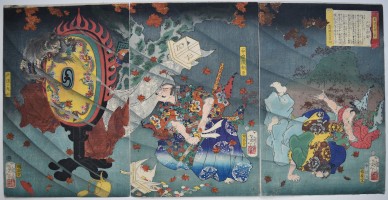
Click here to view image full size.
A triptych from a set Bidan musha hakkei, “Eight Views of Warriors’ Fine Tales.” This design Togakushi no seiran, “Clearing Weather of the Togakushi Mountains.” Princess Sarashina, who is actually a female oni called Momji, “Maple Leaves,” having transformed herself, is seen screaming from behind a giant drum and raising a high wind scattering maple leaves against Taira no Koremori Ason who draws his sword to kill her. Published by Sanoya Tomigoro, 1868.
Extremely fine impression of the earliest state. Fine colour. Slight marks on first sheet, otherwise very good condition. Signed Gekko Yoshitoshi hitsu.
Status: Available
Utagawa HIROSHIGE (1797-1858)
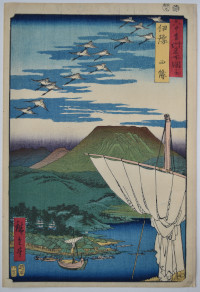
Click here to view image full size.
Iyo Province, Saijo. From a set of 69 prints [Dai Nihon] Rokujuyoshu meisho zue, “Famous Places in the Sixty-odd Provinces [of Japan]” published by Koshihei between 1853 and 1856, this being 1853. A large furled sail in the foreground with Saiju village on the water’s edge. Beyond is Mt. Ishizuchi.
Fine impression and colour. Light album backing, otherwise very good condition. Signed Hiroshige ga.
Status: Available
Utagawa KUNIYOSHI (1797-1861)
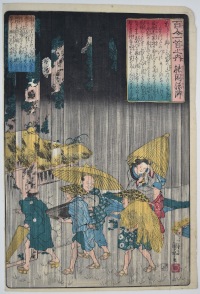
Click here to view image full size.
A poem by the celebrated poet and monk Noin-hoshi from the series Hyakunin isshu no uchi, “One Hundred Poems for One Hundred Poets” which was compiled in 1235 by Fujiwara Teika (1162-1241). A group of travellers are caught in a torrential downpour. One of the best designs in the set published by Ebisuya Shoshichi, Ebine, 1840-42. Only 58 of the 100 are known. Various translations of the poem exist, here is one:
The maples and leaves
Of Mount Mimura –
Making the Tatsuta River
A fine brocade
Very fine impression. Fine colour. Slight nibbling on one margin, otherwise fine condition. Signed Ichiyusai Kuniyoshi ga.
Status: Available
Utagawa HIROSHIGE (1797-1858)
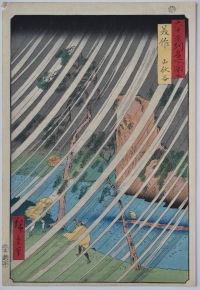
Click here to view image full size.
Mimasaka, Yamabushidani, “Mimasaka [Province], Yamabushi Valley.” Travellers caught in heavy wind and rain in the valley. Hiroshige II also produced an excellent version of this design. From a set of 69 prints [Dai Nihon] Rokujuyoshi meisho zue, “Famous Places in the Sixty-odd Provinces [of Japan]” published by b Koshimuraya Heisuke between 1853 and 1856, this being 1853.
Very fine impression and colour. Light album backing and very small wormhole at extreme edge of margin, top left, otherwise fine condition. Signed Hiroshige ga.
Status: Available
Hishikawa SORI (Active 1797-1813)

Click here to view image full size.
An original painting, full colour on silk, 43.25 x 14 in; 109.8 x 35.6 cms. An early pupil of Hokusai (who gave him his name Hishikawa Sori in 1798, it previously being Tawaraya). Generally referred to as Sori III. Produced a considerable number of small surimono – some of which can be confused with Hokusai’s work. Shows a beauty with a monkey at her feet. There is a print closely following the painting published in 1906. Illustrated in Nihon ukiyoe hakubutsukan, ed., Nikuhitsu ukiyoe senshu gekan (Selected Painting of Ukiyo-e, second vol.) Tokyo: Gakushu kenkyusha, 1985, plate 193.
In very good condition. Signed Hyakurin Sori ga with seal Sori.
Status: Available
TORII School (c. late 1750’s)

Click here to view image full size.
An original painting, full colour on paper with gold additions, image size 30 x 10 in; 76 x 25.5 cms. Shows a beauty holding up a puppet of the actor Bando Hikosaburo II. Painted c. late 1750s and possibly by Torii Kiyomitsu. In good condition with seal Torii.
Status: Available
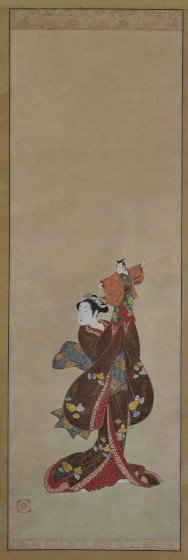
Click here to view image full size.
Kitagawa FUJIMARO (1790-1850)

Click here to view image full size.
An original painting, full colour on silk, image size 35.25 x 13.5 in; 89.5 x 34.5 cms. Fujimaro was a talented late pupil of Utamaro. More than a dozen paintings are recorded by him including an example in the Portland Art Museum, acc. number 69.51. His best-known work is in the collection of the Tokyo National Museum depicting Yujyo risshi-zu and another four paintings of beauties in the four seasons is in the collection of the Ota Memorial Museum of Art, Tokyo. Shows a standing courtesan beside a vase containing peonies and cherry blossom. On her sumptuous costume are the black wheels of a hanaguruma, “flower cart.” These vehicles carried baskets with often elaborate arrangements of flowers. It seems more than coincidence that the vase is placed where the basket would have been on the cart.
Painted c 1820. Signed Fujimaro with seal Yozan. Newly remounted and in fine condition with new box and futo-maki (thick wooden roll to preserve the painting from damage).
Status: Available
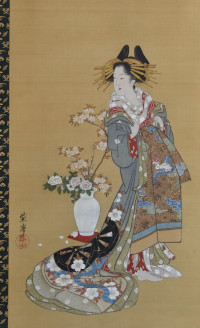
Click here to view image full size.
Tsukioka YOSHITOSHI (1839-1892)
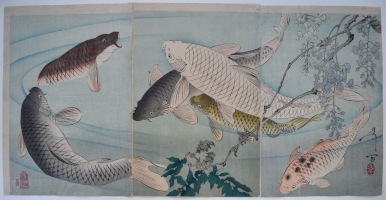
Click here to view image full size.
A triptych showing carp swimming beneath wisteria. A rare and extremely unusual subject in Yoshitoshi’s canon of work. Koi are symbols of love and friendship in Japan. The breeding of ornamental carp began in the 1820s. The outside world was unaware of the advances in breeding colour variations until an annual exposition in Tokyo in 1914. Published by Akiyama Buemon, 1889. There is an original drawing, most likely for this triptych, elsewhere on this site. A much sought after design.
Very fine impression. Fine colour. Completely untrimmed with the extra margins around. Fine condition. Signed Yoshitoshi ga.
Status: Available
Keisai EISEN (1790-1848)
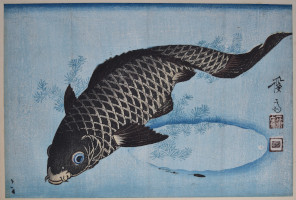
Click here to view image full size.
A carp swimming among water-weed. The moon’s reflection in the blue water. There are various editions of this design: without the moon’s reflection; with and without the censor seal; with and without publisher’s seal; with and without currents in the water. Published by Ezakiya, c. 1843-6. Rare.
Fine impression and colour. Faint vertical folds and two areas of sumi, otherwise very good condition. Signed Keisai with seals Ippitsuan and Keisai.
Status: Available
Utagawa KUNIYOSHI (1797-1861)
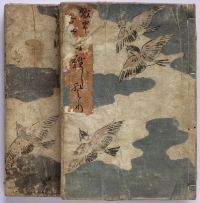
Click here to view image full size.
2 vols. complete: Kanjaku tsuizen hanashidori, “The Liberated Birds: A Memorial Book for Kanjaku.” A memorial book for the actor Nakamura Utaemon who died in 1852. He had the literary name of Kanjaku, meaning ”playing with sparrows” and the covers and many illustrations allude to this custom of releasing birds at funerals. Vol. 1: 1st preface , 3pp. giving the biography of Utaemon IV; poem 1p. 3 sheets: calligraphy (in ishizuri), 1p.; illustrations in colour, 5pp. signed on first page Toyokuni (III). Sheets 1-8: 2nd preface, 5pp., remaining pp. text, poems and colour illustrations. Sheets 1-75 with 15 single-page and 62 double-page illustrations in sumi and light colour. Inside back cover: colophon dated Kaei 5 (1852). Vol. 2: 110 sheets of text, poems, and illustrations. 38 single-page and 50 double-page illustrations (many in colour and includes a double-page illustration by Kuniyoshi). Last page, colophon, dated Kaei 5 (1852). Original covers with clouds and sparrows. Some soil and minor damage. One title slip missing and other damaged. Contents extremely good.
Status: Available
Katsushika HOKUSAI (1760-1849)
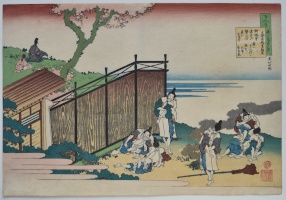
Click here to view image full size.
Hokusai’s interpretation of a poem by Onakatomi no Yoshinobu Ason (921-991). From an unfinished set: Hyakunin isshu uba ga etoki, “Pictures of One Hundred Poems by One Hundred Poets Explained by the Nurse.” The poems are from an anthology Hyakunin isshu, “One Hundred People, One Poem Each” compiled by the poet Fujiwara no Teika (1162-1241). The poet speaks of his love as being like the fire kept by the guards at the gate to the Imperial Palace: It burns hot only at night. There is actually some doubt that the poem can be attributed to Yoshinobu. Shows a group of off-duty Imperial carriage guards relaxing around the smoking embers of a fire. The poet with his servant is seen sitting on the distant hill. Published by Eijudo, 1835-36. A considerable number of original drawings exist for the set that were not turned into prints and are in various museums and private collections.
Fine impression, colour and condition. Signed Saki no Hokusai Manji.
Status: Available
Suzuki HARUNOBU (1724-1770)
Click here to view image full size.
Two volumes complete: Ehon haru no nishiki, “Picture Book: The Brocades of Spring.” Vol. 1: 1 page preface dated Kanoto U (1770); single page and 8 double page colour prints. Vol. 2: 1 single page and 8 double page colour prints. 1 page colophon with date, publisher, block-cutter and artist as Suzuki Harunobu with his seal. 2 pages publisher’s announcements. Published by Yamazaki Kimbe, Edo. This is the first edition, Meiwa 8 (1771). Other copies are in the MFA, Boston, acc. no. 1997.477.1-2 and the Philadelphia Museum of Art, acc. no. 1970-46-1. Provenance: Ex collections H.M.Kaempfer and Hayashi (their seals on the first page of each volume). Original covers and title slips. Covers worn. Some soil and edge restoration.
Very good impressions with generally very good colour. Rare in the first edition.
Status: Available
Utagawa YOSHIHARU (1828-1888)

Click here to view image full size.
Shows Hakujisso Hakusho (Chin. Bai Sheng) subduing a giant bird with a bamboo pole. From a set Suikoden goketsu kagami, “Mirror of Heroes of the Suikoden” published by Yamaguchiya Tobei, 1856. This is the first edition with gradation on the bird’s beak and elsewhere and the signature cartouche printed in red. Later editions lack these refinements.
Very fine impression. Fine colour. Slightly trimmed, otherwise very good condition. Signed Ichibaisai Yoshiharu ga.
Status: Available
Keisai EISEN (1790-1848)

Click here to view image full size.
An amorous couple from an unsigned abuna-e (from abunai, risqué) set of twelve prints Keisai higo, “Secret Words of a Courtesan” published c. 1822-25. Although coming under the heading of shunga, each print is without any graphic details. She adjusts his hair with her hairpin while he smokes a pipe.
Fine impression, colour and condition. (Without centre fold, which is often encountered on this set.
Status: Available
Kikugawa EIZAN (1787-1867)
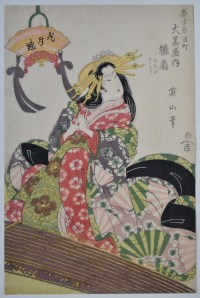
Click here to view image full size.
The geisha Hinaogi of the Daikokuya preparing to play the koto. She is adjusting the tsume (plectra) on her fingers that were used to pluck the strings. The title is enigmatic: It reads Ka getsu kai, “Harbinger of Moon and Flower” and if the character for “moon” is omitted it reads “oiran” (the highest ranking courtesan). Published by Enomotoya Kichibei, c. early 1830s. There is in fact a later copy of this print by Kunisada.
Fine impression. Excellent colour. Very good condition. Signed Eizan hitsu.
Status: Available
Utagawa HIROSHIGE (1797-1858)
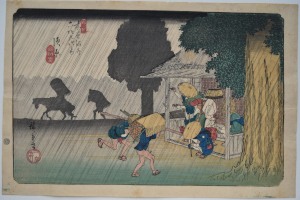
Click here to view image full size.
Station Suhara from Kisokaido rokujukyu tsugi no uchi, “Sixty-nine Stations of the Kisokaido” published by Kinjudo, 1834-1842. The road known as the Nakasendo, “central mountain route,” as opposed to the Tokaido which was the “eastern sea route” was started with Keisai Eisen and finished by Hiroshige who designed 47 prints. This is one of Hiroshige’s most famous designs. Shows travellers sheltering in a wayside shrine from heavy rain with two figures running for its shelter. In the distance, silhouetted, a figure on horseback, another following on foot. Hiroshige based his design on an illustration in Itcho gafu, “Itcho’s Picturebook” by Suzuki Rinsho, 1770. This station is famous for the number of variant states, some lighter, some darker, and variations in the gradation on the trees as the printers strove to capture this stormy scene. This is an early state.
Fine impression with crisp seals. Fine colour and condition with large margins. Signed Hiroshige ga.
Status: Available
Utagawa HIROSHIGE (1797-1858)
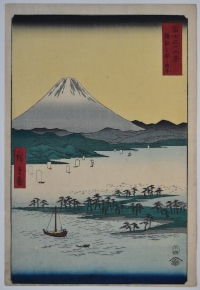
Click here to view image full size.
Suruga, Miho no Matsubara, “Pine Beach of Miho in Suruga [Province]” from Fuji sanjurokkei, “Thirty-six Views of Fuji” published by Tsutaya Kichizo, 1858. A striking design with the yellow sky and one of the best prints from the set. The Miho peninsula has a seven-kilometre seashore lined with pine trees.
Fine early impression and colour with the red signature and title labels double-printed to give a more saturated colour. Fine condition. Signed Hiroshige ga.
Status: Available
Kawanabe KYOSAI (1831-1889)

Click here to view image full size.
A large original painting, full colour on silk, image size 48 x 21.75 in; 122 x 55.25 cms. A draughtsman of great dexterity with a wild, often bizzare , imagination. Loved sake, sometimes painting under its influence. At an early stage studied under Kuniyoshi, then Maemura Towa and later Kano Chinshin before becoming an independent painter at 27. Adept at highly finshed paintings but also produced a large corpus of spontaneous paintings. Shows a standing courtesan with her kamuro. An homage to Hokusai whom he obviously admired.
Highly finished in places but also incorporating quirky elements of Hokusai’s style. Signed Hokusai hitsu-i (“Imitating Hokusai’s brush”) Shojo Kyosai. In very good condition with old double box with an untranslatable annotation on inside of lid comparing him to Hokusai. An important new discovery.
Status: Available
Kawanabe KYOSAI (1831-1889)

Click here to view image full size.
A fine original Kyosai painting, full colour on silk, 47.5 x 16.5 in; 121 x 42 cms. Shows Emma, the King of Hell, walking with and holding an umbrella above a courtesan while a ghoulish oni looks on wearing a costume of gunnera leaves. Emma-O is the Japanese Buddhist version of Yama, the Hindu god of death. It was he who assigned people after death to one of the states of reincarnation. He is shown with the headdress, robes and holding the staff of a Chinese judge. The preparatory drawing for this painting is illustrated in Kawanabe Kyosai, In Honour of 100TH Anniversary of His Death, published by Ukiyoe Ota Kinen Bijutsuken, 1989, no. 61, p. 60. Kyosai was a draughtsman of great dexterity with a wild, often bizarre, imagination. Loved sake, sometimes painting under its influence. At an early stage studied under Kuniyoshi, then Maemura Towa and later Kano Chinshin before becoming an independent painter at 27. Adept at highly finished paintings but also produced a large corpus of spontaneous paintings.
In very good condition. Signed Seisai Kyosai with Kyosai seal.
Status: Available
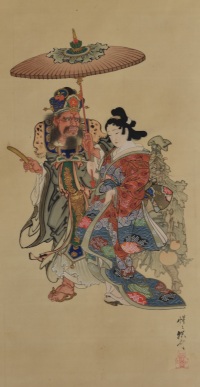
Click here to view image full size.
Taiso YOSHITOSHI (1839 – 1892)
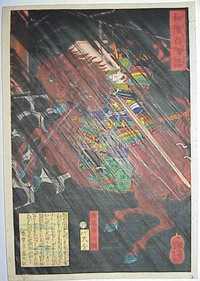
Click here to view image full size.
Watanabe no Tsuna on horseback in the rain. One of the finest designs from Wakan hyaku monogatari. Published by Daikin, 1865/2.
Fine impression and colour. Minor wormage otherwise very good condition. Signed Ikkaisai Yoshitoshi ga.
Status: Available
Kitagawa UTAMARO (1753-1806)
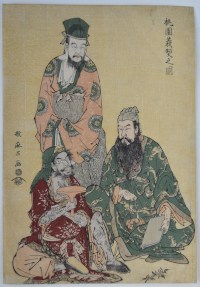
Click here to view image full size.
A scene taken from the Chinese 14th century heroic novel San guo zhi yanyi, “Romance of the Three Kingdoms” attributed to Luo Guanzhong. Shows in the centre Liu Bei (Jap. Ryubei), the founder of the Kingdom of Shu, and the two warriors, Guan Yu (Kan U) on the right and Zhang Fei (Cho Hi) on the left. The three swore pledges of brotherhood in a peach orchard. Toen gikei no zu, “Picture of the Oath in the Peach Orchard. “ Published by Tsutaya Juzaburo with early signature c 1782-3. Rare.
Fine impression. Very good colour: yellow ground. Slight crease down right edge and very small wormage near top right, otherwise very good condition. Signed Utamaro ga.
Status: Available
Utagawa YOSHITORA (1836-1887)
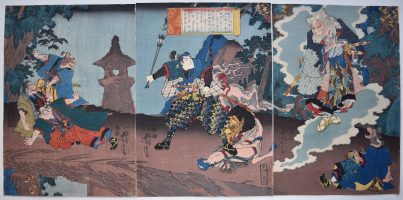
Click here to view image full size.
A triptych showing the warrior Inukai Genpachi (the famous character from the Hakkenden) confronting a cat monster which has emanated from a horse on Mount Koshin. Other cat monsters stare in amazement. Published by Kojimaya Jubei, 1850.
Very fine impression. Fine colour. Imperceptible small binding holes, otherwise fine condition. Signed Ichimosai Yoshitora ga.
Status: Available
Tsukioka YOSHITOSHI (1839-1892)
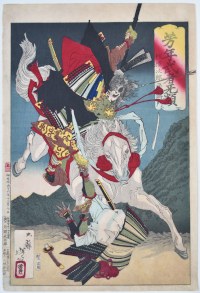
Click here to view image full size.
Shows Sagami Jiro Taira no Masakado on horseback attacking an opponent and having cut his sword in two. From a set Yoshitoshi musha burui, “Yoshitoshi’s Courageous Warriors.” Published by Kobayashi Tetsujiro, 1883.
Very fine impression: This is the first edition with three-colour cartouche and small red seals in left margin. There are late editions of this set. It was republished by Tsunajima Kamekichi in 1886. Fine colour. Slight soil bottom edge, otherwise very good condition. Signed Taiso Yoshitoshi ga.
Status: Available
Utagawa KUNIYOSHI (1797-1861)
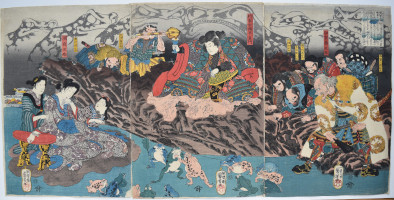
Click here to view image full size.
A triptych showing Shoguntaro Taira Yoshikado (centre), his sister Takiyasha-hime (left), and Yoshikado’s retainer, Iga Jutaro, watching magic toads wrestling. Huge toads loom above them. Shogun Taro Yoshikado mikata wo atsumen ga tame etc. Takiyasha-hime was known for her toad magic which she had gained from a scroll containing their secrets given to her by her brother. Published by Tsuru-ya Kiyemon, 1842-3. Robinson T.89.
Fine impression, colour and condition. Signed Ichiyusai and Chooro Kuniyoshi ga.
Status: Available
Taiso YOSHITOSHI (1839-1892)
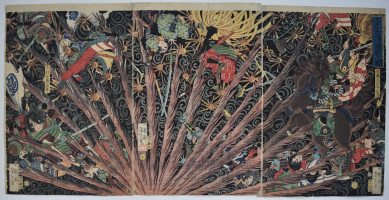
Click here to view image full size.
A triptych showing an exploding land-mine throwing bodies and horses into the ether. Taiheiki Masakiyo nansen no zu, “Masakiyo’s Difficult Battle from the Taiheiki.” Figures identified in the print are the 14th century warriors Sato Shukei no Kami Masakiyo and Shimura Masazo Katsutoyo, but by way of avoiding censorship, it is actually showing Kato Kiyomasa (1562-1611) and Kimura Matazo Shigekatsu. It may also be that the design alludes to the rogue samurai in Choshu Province during the summer of 1866. Published by Yamashiroya Jinbei, 1866. One of Yoshitoshi’s great designs. In fact, this is a reworking of a similar composition in a book early in his career, Ehon jitsugokyo dojikyo yoshu of 1853.
Fine impression and colour. Lovely oxidation of the orange pigment. Fine condition. Signed Ikkaisai Yoshitoshi hitsu.
Status: Available
Katsukawa SHUNJO (?-1787)
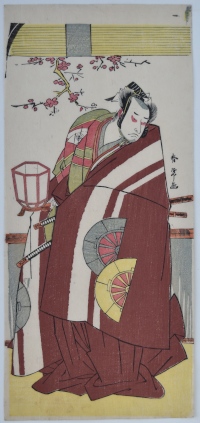
Click here to view image full size.
An hosoban showing the actor Onoe Matsusuke I in a Shibaraku role holding a lantern. (Possibly as Sakata no Kintoki). Shunjo was a pupil of Katsukawa Shunsho. Published c 1780.
Fine impression. Very fine colour and condition. Signed Shunjo ga.
Status: Available
Utagawa KUNISADA (1786-1865)
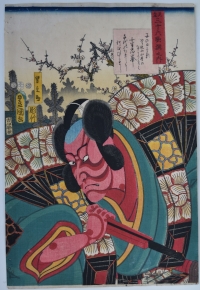
Click here to view image full size.
The actor Ichikawa Danjuro VIII as Arajishi Otokonosuke from a set Mitate sanjurokkasen no uchi, “An Imaginary Thirty-six Poets.” A famous early compilation; in this case the image is inspired by a poem of Mibu no Tadamine. Otokonosuke is usually depicted about to strike his adversary Nikki Danjo -who has turned into a rat – with an iron fan (leaving a red mark on the rat’s/Danjo’s head). Published by Iseya Kanekichi, 1852.
Very fine early impression. Fine colour. Very small binding holes, otherwise very good condition. Signed Toyokuni ga.
Status: Available
Utagawa KUNISADA (1786-1865)
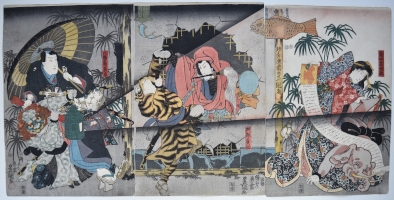
Click here to view image full size.
A triptych of a probably imaginary performance showing the actor Ichimura Uzaemon XII as Hachiman Taro Yoshiie (far left) with an actor dressed as a lion who shines a strong beam from a lantern across the other two sheets; the centre one showing the actor Ichikawa Danjuro III as Abe Sadato with an actor dressed as a lion, and the right sheet showing the actor Bando Shuka I as Sadato’s wife Sodehagi with an actor dressed as an elephant. Published by Miyakozawa 1847-52.
Very good impression, colour and condition. Signed Hanmoto no oujyu Toyokuni ga, “By the request of the publisher, painted by Toyokuni.”
Status: Available
Utagawa HIROSHIGE II (1829-1869)
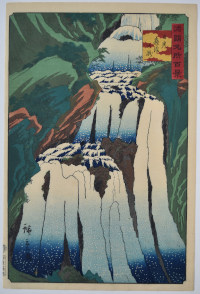
Click here to view image full size.
Nikko Shimofuri no taki, “Shimofuri Waterfall in Nikko” from Shokoku meisho hyakkei, “Hundred Views of Famous Places in the Provinces.” An uncompleted set of 81 prints published by Uoya Eikichi between 1859-1861 (this being 1859).
Fine impression, colour and condition. Signed Hiroshige ga.
Status: Available
Utagawa HIROSHIGE (1797-1858)
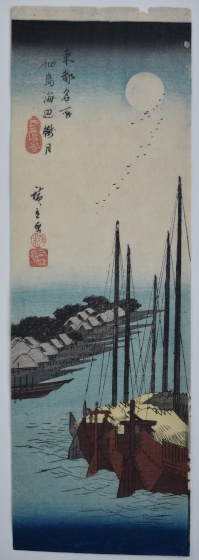
Click here to view image full size.
Spring moon at the shore of Tsukudajima . One of a set of chu-tanzaku prints published by Shogendo, c. 1837. Tsukudajima was one of two islands at the mouth of the Sumida River. Originally a sanbar, it was reclaimed with earth and rocks and given its name by the first Tokugawa Shogun, Ieyasu, who invited thirty-three fishermen to live there in 1613 in order to provide fish for the rapidly expanding city of Edo. The fishermen came from Tsukudama near Osaka and it was they who became the proprietors of what would become the Tsukiji fish market. It must have been popular during the late Edo period as a place to visit and view the boats from teahouses on the shore because there are many prints depicting the area, especially under a full moon.
Fine impression, colour and condition. Signed Hiroshige ga. n.
Status: Available
Utagawa HIROSHIGE (1797-1858)
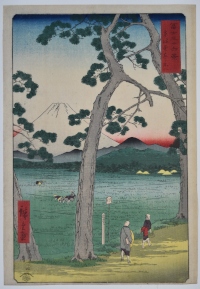
Click here to view image full size.
Tokaido hidari Fuji, “Fuji Seen from the left on the Tokaido [Road]” from Fuji sanjurokkei, “Thirty-six Views of Fuji” published by Tsutaya Kichizo, 1858. Shows travellers on the Tokaido Road at Oiso with workers in rice paddies beyond.
Fine early impression and colour with the red signature and title labels double-printed to give a more saturated colour. Bottom margin trimmed close, otherwise fine condition. Signed Hiroshige ga.
Status: Available
Utagawa HIROSHIGE (1797-1858)
Click here to view image full size.
An important pair of original paintings, light colour on silk, 35.5 x 12.75 in; 90 x 32.5 cms. The left painting shows Asukayama in the Eastern Capital (Edo). This was one of the top areas to view the abundant cherry trees, the first of which were planted by the Shogun Tokugawa Yoshimune. A fir tree is seen to the left with cherry trees on the lower slope and a majestic Fuji in the distance. A large foreground object, often only partly shown, is a characteristic of many Hiroshige paintings and prints: They lead the eye into a composition and give perspective. The right-hand painting shows the Sumida River in the Eastern Capital (Edo) with a flowering cherry tree in the foreground. (See the comment above.) The sakura flowers from the end of March to early May and the sakura-zensen, blossom forecast, by the weather forecasters is watched assiduously as the blossom is so transient.
Each painting signed Ryusai with Hiroshige seal. Hiroshige produced a number of paintings in this format with this signature and seal, c. early 1850s. In good condition.
Status: Available
Kawanabe KYOSAI (1831-1889)
Click here to view image full size.
A fine original Kyosai painting, full colour on paper, 51.5 x 21.5 in; 131 x 54.5 cms. Shows Otafuku being carried across a river on the back of a blue oni. They look down with consternation at a red oni who has fallen into the water spilling his basket of mushrooms. The face of the blue oni takes on the appearance of Hyottoko, the male pairing of Otafuku. Known as the Goddess of Mirth, Otafuku is often shown with the Seven Gods of Good Fortune. There are various theories as to her origins and her face, in the form of a mask, has become ubiquitous. Kyosai was a draughtsman of great dexterity with a wild, often bizarre, imagination. Loved sake, sometimes painting under its influence. At an early stage studied under Kuniyoshi, then Maemura Towa and later Kano Chinshin before becoming an independent painter at 27. Adept at highly finished paintings but also produced a large corpus of spontaneous paintings.
In very good condition. Provenance: The inside of the lid on the box is signed and sealed by Mano Gyotei (Kyotei) who was Kyosai’s pupil and guarantees the painting. Sealed Kyosai.
Status: Available
Totoya HOKKEI (1780-1850)
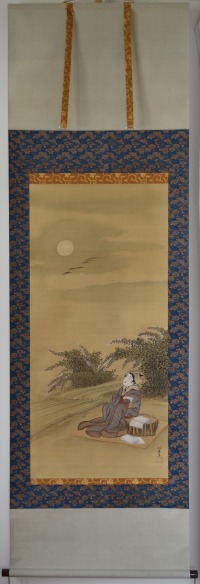
Click here to view image full size.
An original painting by Hokkei, full colour on silk, 41.5 x 19.25 in; 105.5 x 49 cms. Hokkei was one of the earliest and best pupils of Hokusai. Probably best known for his large output of surimono, but also produced illustrated books and paintings. Shows a beauty fulling cloth beside the Kinuta River, Settsu Province. She gazes at the full moon and a flight of geese. On each side of the stream is Japanese bush clover, associated in Japan with autumnal melancholy and unrequited love.
Signed Hokkei ga with Hokkei seal.
Status: Available
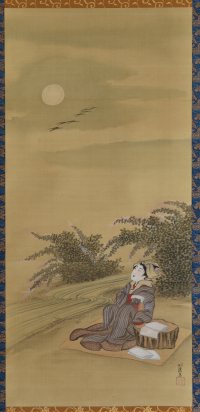
Click here to view image full size.
Toyohara KUNICHIKA (1835-1900)
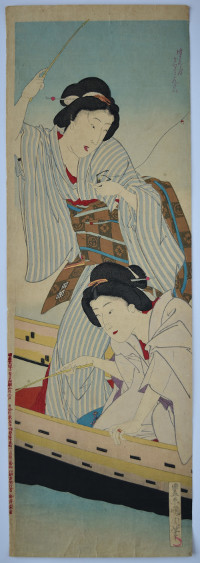
Click here to view image full size.
A cho-oban (20 x 6.75 inches) print showing beauties fishing. The top figure has caught a crayfish. Each design interprets a haiku poem in red, top right. A set of 6 prints published by Matsui Eikichi, 1893. Rare.
Fine impression and colour. Slight creasing, otherwise fine condition. Signed Toyohara Kunichika hitsu.
Status: Available
Kikugawa EIZAN (1787-1867)
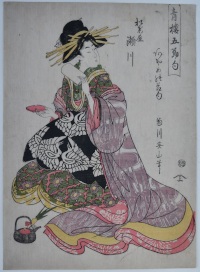
Click here to view image full size.
An aiban print showing the courtesan Segawa of the Matsubaya drinking ayamezake (a sake soaked with iris root) from a set Seiro gosekku, “Beauties of the Yoshiwara Compared to the Five Festivals.” In this case the Boys’ Festival held on the 5th May. Published by Iseya Soemon, c 1810.
Fine impression, very good colour and condition. Signed Kikugawa Eizan fude.
Status: Available
Utagawa KUNISADA (1786-1865)
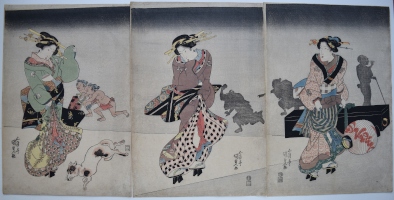
Click here to view image full size.
An untitled triptych showing two beauties and a maidservant lighting their way with a lantern and carrying a shamisen box. The beam of light from the lantern illuminates the foreground figures and a leaping dog but leaves the background figures in silhouette. Published by Mikawaya Seimon, c. mid 1820s. A fine design.
Fine impression and colour. Imperceptible fold, otherwise very good condition. Signed Gototei Kunisada ga.
Status: Available
